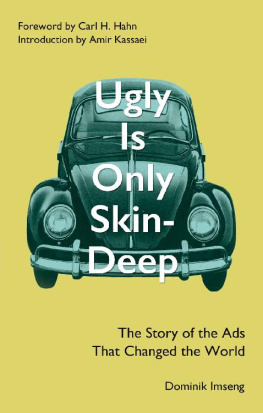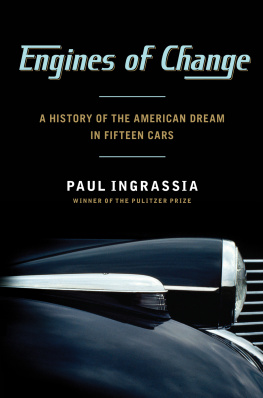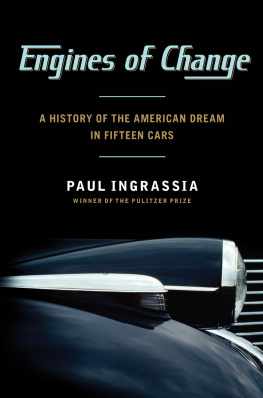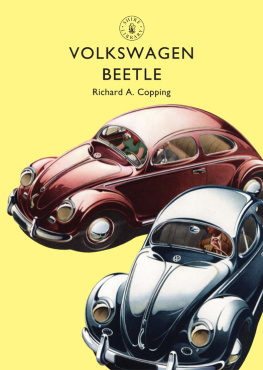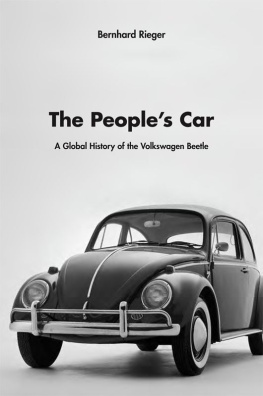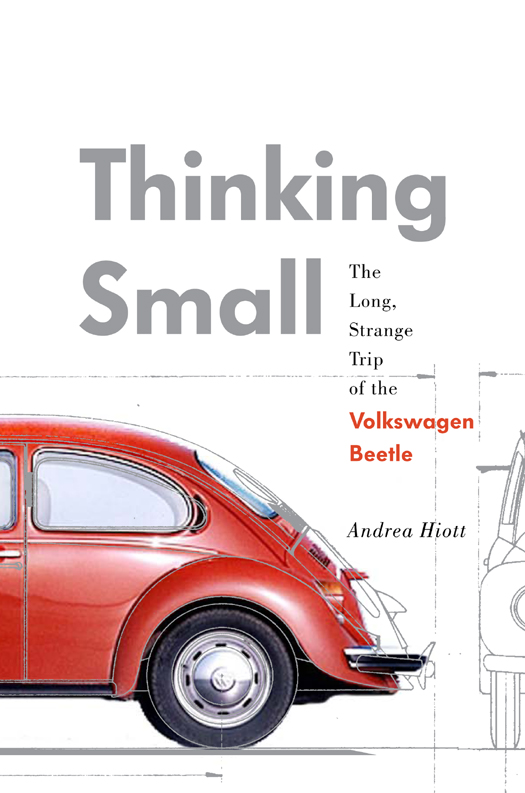Copyright 2012 by Andrea Hiott
All rights reserved.
Published in the United States by Ballantine Books, an imprint of The Random House Publishing Group, a division of Random House, Inc., New York.
B ALLANTINE and colophon are registered trademarks of Random House, Inc.
LIBRARY OF CONGRESS CATALOGING-IN-PUBLICATION DATA
Hiott, Andrea.
Thinking small : the long, strange trip of the Volkswagen Beetle / Andrea Hiott.
p. cm.
Includes bibliographical references and index.
ISBN 978-0-345-52142-2 (hardcover)eISBN: 978-0-345-52144-6
1. Volkswagen Beetle automobileHistory. I. Title.
TL215.V618H56 2012
629.2222dc23 2011041090
www.ballantinebooks.com
FIRST EDITION
v3.1_r1
For all those driven
by hunger and love
Contents
Photo Credits
From the archives of Volkswagen of America
2011 DDB Worldwide
Private
Private
From New York Worlds Fair 19391940 records, Manuscripts and Archives Division, The New York Public Library, Astor, Lenox and Tilden Foundations
From Porsche AG (Porsche-Werkfoto)
From Porsche AG (Porsche-Werkfoto)
From Porsche AG (Porsche-Werkfoto)
From Porsche AG (Porsche-Werkfoto)
From Porsche AG (Porsche-Werkfoto)
From Porsche AG (Porsche-Werkfoto)
From Porsche AG (Porsche-Werkfoto)
From the collections of The Henry Ford
From Porsche AG (Porsche-Werkfoto)
From Volkswagen Aktiengesellschaft
From Porsche AG (Porsche-Werkfoto)
From Porsche AG (Porsche-Werkfoto)
From Porsche AG (Porsche-Werkfoto)
From Porsche AG (Porsche-Werkfoto)
From Porsche AG (Porsche-Werkfoto)
From Porsche AG (Porsche-Werkfoto)
From Porsche AG (Porsche-Werkfoto)
From Porsche AG (Porsche-Werkfoto)
From Porsche AG (Porsche-Werkfoto)
From Porsche AG (Porsche-Werkfoto)
From Porsche AG (Porsche-Werkfoto)
From the Institut fr Zeitgeschichte und Stadtprsentation Wolfsburg
From the Institut fr Zeitgeschichte und Stadtprsentation Wolfsburg
From the Institut fr Zeitgeschichte und Stadtprsentation Wolfsburg
From Porsche AG (Porsche-Werkfoto)
From Porsche AG (Porsche-Werkfoto)
From the Institut fr Zeitgeschichte und Stadtprsentation Wolfsburg
From Volkswagen Aktiengesellschaft
From Volkswagen Aktiengesellschaft
2011 DDB Worldwide
From the Institut fr Zeitgeschichte und Stadtprsentation Wolfsburg
From Volkswagen Aktiengesellschaft
From Porsche AG (Porsche-Werkfoto)
From Porsche AG (Porsche-Werkfoto)
From Porsche AG (Porsche-Werkfoto)
From Porsche AG (Porsche-Werkfoto)
From the Institut fr Zeitgeschichte und Stadtprsentation Wolfsburg
From Porsche AG (Porsche-Werkfoto)
From Porsche AG (Porsche-Werkfoto)
2011 DDB Worldwide, with permission from Kathryn Krone
From the archives of Julian Koenig
From the archives of George Lois
From the Institut fr Zeitgeschichte und Stadtprsentation Wolfsburg
From the Institut fr Zeitgeschichte und Stadtprsentation Wolfsburg
From the Institut fr Zeitgeschichte und Stadtprsentation Wolfsburg
From the Institut fr Zeitgeschichte und Stadtprsentation Wolfsburg
From Volkswagen Aktiengesellschaft
From Volkswagen Aktiengesellschaft
From General Motors LLC. Used with permission, GM Media Archives
From Volkswagen Aktiengesellschaft
From Volkswagen Aktiengesellschaft
From the Institut fr Zeitgeschichte und Stadtprsentation Wolfsburg
Used by permission of Klaus Gottschick, Wolfsburg
From Volkswagen Aktiengesellschaft
From the Museum at Bethel Woods, 1969/2009 Doug Lenier, all rights reserved (photo has been cropped)
From the Museum at Bethel Woods, 1969/2009 Doug Lenier, all rights reserved (photo has been cropped)
Used by permission of Klemens Ortmeyer, courtesy of the Phaeno Science Center
Photograph by Mark Henderson, courtesy of the Autostadt
Photograph by Lars Landmann, courtesy of the Autostadt
From the archives of George Lois
From the archives of George Lois
From Volkswagen of America
From Volkswagen of America
From Porsche AG (Porsche-Werkfoto)
What is love? After all, it is quite simple. Love is everything which enhances, widens, and enriches our life, in its height and in its depths. Love has as few problems as a motor-car. The only problems are the drivers, the passengers, and the road.
Franz Kafka
Introduction
In 1949, a ship called the MS Westerdam departed from the coast of Europe, its hundreds of passengers headed toward U.S. shores. Nestled deep in the ships cargo compartment, a pair of headlights peeped out of a dark tarp; two wide, open circles leading to the soft curves of what would soon be known as the worlds most recognizable car. Protesters, rebels, dissidents, politicians, businessmen, the worlds corporate eliteall would eventually become entwined in its story. By the end of the 1960s, it would do what no other car had done before: transcend age, class, and country to become a symbol adopted by them all. Americans would call the car the Beetle. In other places it would become the Flea, the Turtle, the Vocho, the Foxi, the Buba, the Fusca, the Poncho, and the Mouse.
Over the years, the car developed a cult following as well as a more public persona. It had fan club after fan club created on its behalf; it showed up in the films of Woody Allen and Stanley Kubrick; Disney endearingly dubbed it The Love Bug; it was even drivenbrieflyby James Bond. For decades, the car filled college towns and campuses, the choice of students and faculty alike. It appeared on the cover of Abbey Road. John Lennon had a white one in his driveway. Packs of them dotted the beaches of California, surfboards strapped to their roofs. A childrens game even spontaneously developed around the car as kids scanned the roads in search of it: Punch Bug red! No punch back! The car became so ubiquitous that pop artist Andy Warhol included it in his iconic series of silk screens, placing it in the company of personalities such as Elvis and Marilyn Monroe.
Today the original Volkswagen is still known as the longest-running and best-selling single car design in history, and it is the only car to have been brought back by popular demand twice. Sometimes referred to as the worlds most huggable car, perhaps no other automobile has ever been lavished with such attention and affection. But onboard the MS Westerdam on that cold winter day in 1949, none of that had yet come to pass. In those days, very few thought the car had potential. Reaching U.S. shores for the first time, the car had much more in common with the millions of immigrants coming over on similar ships, men and women who had been through dark times and were now seeking refuge or hoping to reinvent themselves, eager to find out if what theyd heard about the American dream was real.
It had been a long road. In fact, after nearly two decades of work and planning, the Volkswagen had only barely made it into existence at all. During the Second World War, the cars country and factory were all but destroyed. Caught in the ugliness of the Nazi machine, it became a symbol of the hated party. By 1949, one of the men responsible for it had committed suicide and another had been kidnapped and placed in prison, where he languished, imagining hed failed to fulfill one of his lifelong dreams.





